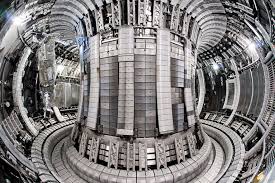World Record For Nuclear Fusion:

A world record for nuclear fusion has been smashed after the WEST Tokamak reactor, in southern France, was able to maintain plasma for more than 22 minutes.
- Nuclear fusion is the process by which two light atomic nuclei combine to form a single heavier one while releasing massive amounts of energy.
- The process releases energy because the total mass of the resulting single nucleus is less than the mass of the two original nuclei.
- The leftover mass becomes energy.
- Fusion reactions take place in a state of matter called plasma — a hot, charged gas made of positive ions and free-moving electrons with unique properties distinct from solids, liquids or gases.
- The sun, along with all other stars, is powered by this reaction.
- The devices designated for the task of doing this here on Earth—nuclear fusion reactors — are called tokamaks.
- Tokamaks are often also called ‘artificial suns’ due to the fact that these doughnut-shaped machines replicate processes that occur in the sun.
- There are currently over 200 tokamaks in operation across the globe with the scientific milestones achieved in these devices developing a roadmap for the operation of the International Thermonuclear Experimental Reactor, or ITER, the world’s largest fusion experiment.
- A commercial tokamak will aim to use the thermal energy of plasma heated by fusion to heat water, create steam, and, in turn, spin a turbine that generates electricity.
- Fusion can involve many different elements in the periodic table. However, researchers working on fusion energy applications are especially interested in deuterium-tritium (DT) fusion.
- DT fusion produces a neutron and a helium nucleus. In the process, it also releases much more energy than most fusion.




